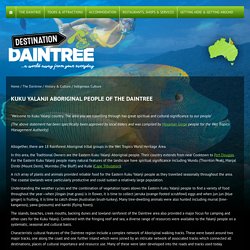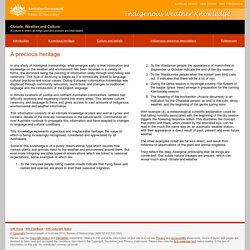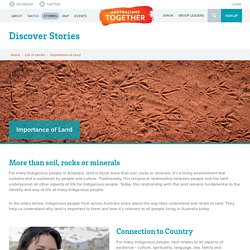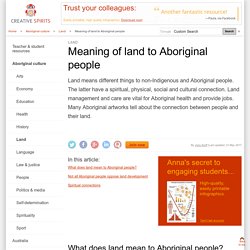Perception of environments
> Jssacslib
> Stage 2 Geography: China and Australia (Earth's Environment)
Aboriginal cultural heritage. Recognising our rangers - WWF-Australia - WWF-Australia. By Jessica Chapman Indigenous ranger groups are integral to the management of threatened species and their habitats across Australia.

I see this first-hand in the remote Kimberley region.
ENERGY STAR KIDS & Lorax. Aboriginal Culture of the indigenous people of the Daintree. ‘Welcome to Kuku Yalanji country.

The area you are travelling through has great spiritual and cultural significance to our people’ (The above statement has been specifically been approved by local elders and was compiled by Mossman Gorge people for the Wet Tropics Management Authority) Altogether, there are 18 Rainforest Aboriginal tribal groups in the Wet Tropics World Heritage Area. In this area, the Traditional Owners are the Eastern Kuku Yalanji Aboriginal people. Their country extends from near Cooktown to Port Douglas.
Indigenous Connections - Cool Australia. When we talk about learning to live in harmony with our environment it can be easy to forget that there are people in Australia who have been doing this for longer than most of us can imagine. Australia’s indigenous peoples have a huge amount of knowledge about our country and a strong connection to the land. They also have a relationship with the environment that is incredibly sustainable.
Indigenous Weather Knowledge - A Precious Heritage. In any study of Aboriginal meteorology, what emerges early is that information and knowledge on the weather and environment has been recorded in a variety of forms, the dominant being the passing of information orally through storytelling and ceremony.

This type of archiving is fragile as it is intrinsically linked to language, cultural practices and social values. During European colonisation knowledge was displaced through community relocation, restrictions and changes to traditional language and the introduction of the English language. In remote locations of central and northern Australian communities, settlers had difficulty exploring and expanding control into many areas. This allowed culture, ceremony and language to thrive and gives access to vast amounts of Indigenous environmental and weather information.
Indigenous Weather Knowledge - Bureau of Meteorology. Aboriginal and Torres Strait Islander people have developed an intricate understanding of the environment over many thousands of years.

Artist: Laurie Nilsen The artwork used in the design of this website represents the relationships between seasonal, meteorological and astronomical changes - and how the Mandandanji people read these changes to inform life on country. About the Indigenous Weather Knowledge website. Australians Together. More than soil, rocks or minerals For many Indigenous people in Australia, land is much more than soil, rocks or minerals.

It’s a living environment that sustains and is sustained by people and culture. Traditionally, this reciprocal relationship between people and the land underpinned all other aspects of life for Indigenous people. Today, this relationship with the land remains fundamental to the identity and way of life of many Indigenous people.
Meaning of land to Aboriginal people - Creative Spirits. What does land mean to Aboriginal people?

Non-Indigenous people and land owners might consider land as something they own, a commodity to be bought and sold, an asset to make profit from, but also a means to make a living off it or simply ‘home’ [1]. They ‘develop’ land, as if it was unfinished or raw.
A Brief Aboriginal History. “The very ink with which all history is written is merely fluid prejudice.”

Mark Twain Since the European invasion of Australia in 1788, the Aboriginal people have been oppressed into a world unnatural to their existence for thousands of years. First came the influx of the strangers who carried with them diseases, which decimated the immediate population of the Sydney tribes. It is estimated that over 750,000 Aboriginal people inhabited the island continent in 1788.
Indigenous Weather Knowledge - Introduction to Climate Culture. A history of Aboriginal and Torres Strait Islander culture Aboriginal and Torres Strait Islander people have lived in Australia for at least 50 000 years, with recent evidence suggesting far earlier human occupation of the Australian continent.

Aboriginal people developed unique methods of living which enabled life and community to flourish in even the harshest environments and have allowed the sustained development of the world's oldest continuing culture. Australia is home to hundreds of individual nations or countries, each with distinct cultural practices, beliefs and languages. These cultural practices involve a deep spiritual understanding of the environment and govern how communities live with and maintain the land, plants and animals of their region.
Ausecosystemspreview. Exploring the Relationship between Human Activity and Habitat Loss in the Amazon - National Geographic Society. 1.

Engage student interest by introducing the plan to build a transcontinental railroad in the Amazon rain forest. Distribute the map Amazonia: The Human Impact to students.









